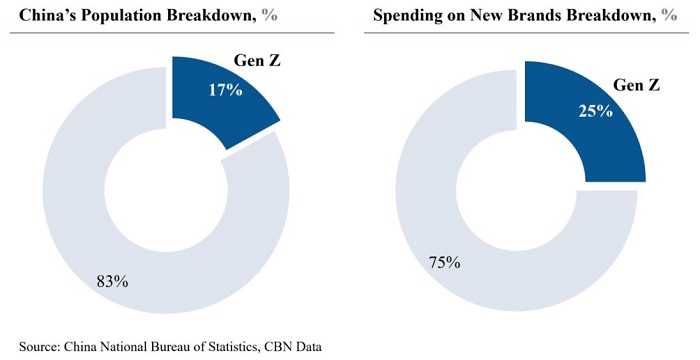China’s digital landscape is in a constant state of flux. Everything in the country has become literally at one’s fingertips, whether it’s on a mobile device or through a click of a desktop mouse. Gen Z was born into this evolving landscape and is the global demographic of people born between 1995 and 2009 – the generation succeeding Millennials. The unique characteristic of Gen Z is they are digital natives. The group now accounts for 19 percent of China’s total population at 260 million.
However, with this comfortable life comes high-maintenance lifestyles and a preference for convenience. There's also pressure on most Gen Zs to meet their family's expectations because they've been given the resources to get ahead in life. Most of them are competitive and are used to a stressful life that revolves around school and subsequently, works. Interestingly, this mix of good and bad has influenced Gen Z’s consumer behavior and subsequently, China's overall digital landscape.
Gen Z’s digital consumption
Gen Z is naturally tech-savvy since they’ve grown up in a world of mobile devices and apps; they know how social media works. This innate tech-savviness makes information more accessible to them, beyond the confines of traditional school. In China, a study found that Gen Z consumers are as mature as older generations when it comes to consuming luxury and fashion items. They do not believe that a high price point is the sole determining factor of a luxury brand. Instead, to be considered a luxury item it must have high quality and good aesthetics.
To get a full picture of how Gen Z spends, it’s important to look at what drives digital consumerism in China. Among the factors affecting consumption in retail integration, also known as the rise of Omni channels. More than 50% of China’s economic growth is attributed to this. In the midst of the pandemic, even big retail brands shifted online to continue their business. These days, it’s common for consumers to either look online and buy in person or look at retail in person and make the final decision to buy online. For some, it’s a matter of price discounts, while for others it’s a matter of convenience.
Social media is also a driving force behind China’s consumerism. Aside from traditional celebrities seen in movies and on television, China has experienced growth in key online influencers whose popularity boomed on social media platforms. This unlikely rise to stardom has influenced even traditional celebrities to grow their influence online as well to take advantage of this digital reach.
Smart cities expanding in China also contribute to consumer behavior. This endeavor has shed light on the need for sustainable products and also made services available digitally. These days, it’s common for app services to employ a holistic approach. Now tech has allowed people to live and work in the comfort of their own homes. Consequently, delivery services have seen rapid growth to keep up with growing demand.
Check out the regular consumer trends: 5 unique habits of online shoppers in China
How Gen Z spends
Despite their maturity in recognizing brands, Gen Zs aren’t the thriftiest. They are impulsive buyers, mainly because it’s very easy to access what they want online. Businesses, especially those that operate DTC (direct-to-consumer), are allowing more personalization of products and services. Gen Z consumers eager to express their own creativity aren’t hesitating to spend on whatever they desire.
In L Catterton’s 2021 consumer insights report on China, they found that even though Gen Z’s population in China is only 17% of the total population, 25% of the total expenditure on new brands in the country comes from this generation. They are largely interested in “made in China” products, thus driving the growth of homegrown brands such as Pop Mart (toys) and Perfect Diary (cosmetics). Gen Zs are driving the growth of “made in China” products, especially in retail and fashion.

In another study done by McKinsey, Gen Zs were found to be relatively more comfortable owing money. Even university students with no credit histories have access to financial products that enable them to buy what they want. They’ve been referred to as the “moonlight clan,” which in Chinese culture is a reference to lunar cycles. Most of the value-good brands are comfortable with loans just to be able to live the life they want. Perhaps due to their upbringing, this generation also has gained the confidence to live this way because of their education. They are confident they will always find a job to sustain their lifestyle.
What do you need to know about WeChat Mini programs?
How to reach Gen Z buyers
Since the Gen Z generation is digital natives – as an online business, you need to know which of the latest technologies and trends you should use to reach them. Here are some insights you might consider to target Gen Z customers:
Online credit systems
As mentioned previously, Gen Z consumers have a tendency to be impulse buyers. This is mainly because they know financing options are available for them online. Among these are Ant Financial’s Huabei virtual credit card, which draws a quarter of its user base from consumers aged 25 years and younger. Another popular alternative is JD.com’s Baitiao card, which enables customers to buy now and pay later, as well as a multitude of other financial products. Gen Zs are not afraid of spending on credit. This is why they also indulge in luxury items and are often living paycheck-to-paycheck.
Know more about China’s unique eCommerce and mobile payment ecosystem.
Social media apps
Social media has evolved from being a mere platform of expression. Now it has become a marketplace for sales and promotions, which has been accelerated by the pandemic. Generation Z is prolific with social media and tends to have more profiles, check their accounts more frequently, and spend longer amounts of time browsing. With this type of behavior, Gen Zs are more likely to be influenced by friends and celebrities which could result in the following brands and finding purchase inspirations to influence their transactions.
In one study on Gen Z’s spending habits, they found that 51% of Gen Z consumers consider official brand social media accounts as one of their top three sources of influence, while 44% of them counted bloggers and online influencers as part of their top three sources of influence when making a purchase. Douyin (parent of TikTok) is top of mind when it comes to social media apps as well as Dianping and Meituan because they offer reviews, discussion forums, and group buying options.
Learn how to optimize for native mobile web browsers in China.
Personalized approach
Gen Zs are also particular with their individuality. They prefer brands that allow them to stand out and brands that offer a personal connection. For example, Genki Forest’s slogan, “Zero Sugar, Zero Fat, Zero Calorie” was built from an online-first approach to marketing which also underscores Gen Z's health-conscious values. The brand's attractive packaging and focuses on natural premium ingredients directly address Gen Zs' demand for high-quality products.
Since they are also tech-savvy, Gen Zs have no problem expressing themselves online. They are among the groups driving the use of Weibo and WeChat moments. Thus, it is important to provide a business that doesn’t give them a one-size-fits-all type of product. The McKinsey study also found that more than 50% of China’s Gen Z consumers prefer brands that offer customized products, while another 53% opted for brands that provide tailored services. To experiment with these findings, luxury brands like YSL launched a unique line of lipsticks that allow consumers to engrave personal messages onto the case, which also taps into China’s unique gift-giving culture.
As the most visible online and perhaps also the tech savviest member of China’s digital economy, Gen Z is a very important class of consumers that are worth the investment. You should be excited to learn how their online habits can shape and transform your business, especially if you are an e-commerce site. Therefore, website testing should be an essential part of your business strategy so you can gain insights into the buying behaviors of this influential and dynamic consumer demographic.
To learn more about succeeding in China, check out our other articles.
If you want to learn more about testing in China, check out our solutions.



